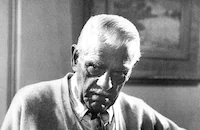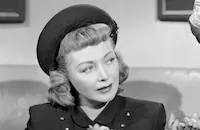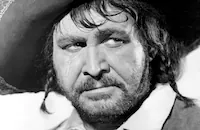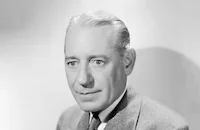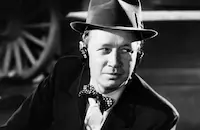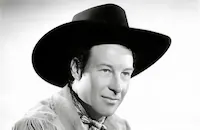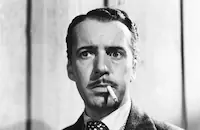Horror pictures had a hard time of it after the enforcement of the Production Code in 1934. The gangster genre
squeaked by with a shift of emphasis from racketeers to G-Men, but Hollywood's new Sunday School mindset rejected
many horror themes outright. Great pictures like Edgar Ulmer's
The Black Cat (which on its own embraced sadism,
suicide and necrophilia) simply disappeared from screens. Post- Code horrors ran for cover behind Edgar Allan Poe
(
The Raven) or comedy (
The Bride of Frankenstein). A few uncommercial exceptions aside, the Horror
Film's full recovery came only 25 years later, when fans embraced Hammer Films' Technicolor exercises in Guignol.
Warners' four-title
Karloff & Lugosi Horror Classics DVD set shows the genre in a definite slump. The final
title in the set is a 1958 cheapie exploiting the still-potent name and fame of the King of Horror, Boris
Karloff.
The Walking Dead from 1936 is a pivotal film for Karloff. Although very short (65 minutes) it's a quality
Warner Bros. effort directed by the respected Michael Curtiz. The plot is essentially a gangster vengeance movie.
Framed by vicious hoods Ricardo Cortez and Barton MacLane, unlucky ex-con John Ellman (Karloff) is executed for a
murder he didn't commit. But his body is revived by scientist Dr. Beaumont (Edmund Gwenn), who wants Ellman to tell
him of secrets beyond the grave.
As can be guessed, the film's genre identity is somewhat confused. Director Curtiz handles the gangster aspect in
familiar Warners' style, with Joe Sawyer playing a Murder, Inc.- style hit man named Trigger. Curtiz and Karloff put
equal effort into the spooky content, splashing Germanic shadows across walls and arranging for the undead Ellman to
unaccountably materialize in locked rooms, like a ghost. Ellman eventually migrates to a rain-soaked cemetery, as if
drawn to death; amid all the fast "Warner Urban" wisecracks and action, Karloff must carry the horror angle on his
own.
Oddly enough,
The Walking Dead is identical in structure and similar in execution to John Boorman's spacey
crime revenge saga
Point Blank. Like that
film's Lee Marvin, Karloff's Ellman is presumed dead yet returns to menace his enemies, all of whom perish without
his direct assistance. In Ellman's case they fall on their own guns or out of windows, under trains, etc.
Karloff lumbers about like Frankenstein's monster, an effect heightened by removing a dental bridge and sucking in
his right cheek to augment the cadaverous look. Like a ghost, Ellman asks each villain, "Why did you have me killed?"
The inconsistent
The Walking Dead never decides if Ellman is a literal zombie or a "Telltale Heart" guilt
hallucination. The faux-religious ending chastens Edmund Gwenn with a "man was not meant to know" message, over an
image of a stone angel in the cemetery.
Karloff is of course superb while the other leads deliver characteristically snappy Curtiz performances. Marguerite
Churchill and Warren Hull are a truly insipid pair of youthful lab assistants never taken to task for refusing to
testify for Ellman at his murder trial.
The Walking Dead looks much more modern than the same year's
The
Invisible Ray but it marks the end of the first phase of Karloff's Hollywood career. From here on he'd land less
prestigious roles, albeit always with star billing. Karloff would repeat the theme of vengeance from beyond the grave
ad infinitum in a series of cheap Columbia pictures.
Author Greg Mank goes deep into
The Walking Dead's production history for his commentary, detailing a long
list of no-no content nixed by the Production Code office before filming began. 1930s Hollywood horror was dismantled
by censor demands both here and in England, where a number of the earlier movies had been banned outright.
Universal's 1939
Tower of London and
Son of Frankenstein cued a significant comeback for the horror
film, but Karloff soon found himself typed as a mad doctor or glowering criminal. Before withdrawing to a much more
rewarding Broadway career he appeared in a rush of minor scare pictures, eight in 1940 alone. RKO's
You'll Find
Out is actually a musical comedy, a vehicle for Kay Kyser's novelty "Kollege of Musical Knowledge" swing
orchestra. Kyser's band of extroverts are more amenable to film work than most musicians, although comedian Ish
Kabibble is perhaps Not Ready for The Big Screen -- he's like a fourth, even more unpleasant Stooge.
The movie is a standard kill-the-heir non-mystery, with Kyser's band performing at the high-toned Bellacrest mansion.
Agent Chuck Deems (Dennis O'Keefe) is in love with Janis Bellacrest (Helen Parrish), the innocent target of a crooked
judge, a charlatan psychic and an assassin posing as a professor: Boris Karloff, Bela Lugosi and Peter Lorre. Each of
these actors is asked only to present their established screen personas. In a plotline dotted with novelty songs and
séance hocus-pocus, the waste of great talent is almost painful. Karloff and Lugosi play the script straight
and manage to survive with their dignity intact. Impish scene-stealer and ad-libber Peter Lorre has a field day using
his eyes and toothy smile to add layers of gleeful malice to his performance.
With the bridge out and the phones dead the three villains try out poisoned darts, bolts of electricity and a falling
spike as murder weapons. Kyser uncovers the evil scheme when he discovers Lugosi's lair in a subterranean room. The
so-called horror angle wraps up much like a Droopy cartoon, with Ish Kabibble's pooch chasing the villains while
carrying a stick of dynamite in his mouth. As a comedy
You'll Find Out is likely to leave modern audiences
completely unmoved.
Peter Frampton fans might be amused by the debut of a "talk box" invention called the Sonovox, which uses the voice
as a filter for amplified musical instruments. Kay Kyser promotes the device as if the movie were an infomercial.
Much more central to film historians is the set dressing used in Lugosi's secret chamber. The art directors raided
the RKO prop department and unearthed a pair of Triceratops stop-motion animation models that may have been built for
Willis O'Brien's aborted dinosaur epic
Creation. Even more interesting are two spider models attached to a
secret doorway -- they look awfully similar to the surviving still of the giant spiders in the famous censored
"spider pit" scene cut from the original
King Kong.
Some wartime horror pictures were haunted house comedies following in the footsteps of popular Bob Hope and Abbott &
Costello hits. 1945's
Zombies on Broadway is a bizarre comedic wanna-be from Wally Brown and Alan Carney,
RKO's answer to Abbott & Costello. The duo's dynamic is definitely personality-challenged; as a comedy team it simply
doesn't distinguish itself.
But
Zombies on Broadway may be the strangest quasi-sequel ever made. Brown and Carney are Jerry Miles and Mike
Streger, maladroit publicity flacks who have promised to find a fake zombie for the new nightclub of gangster Ace
Miller (Sheldon Leonard). Ordered to come up with the real McCoy or die, the pair sails to the Caribbean island of
San Sebastian, a noted zombie hangout. They're greeted at the dock by Calypso singer Sir Lancelot, who improvises an
instant folk ballad commentary. It's immediately apparent that this is a comedy spin-off from Val Lewton's popular
'straight' horror film
I Walked with a Zombie.
Not only does Sir Lancelot recycle his same menacing song from the Lewton original, but the tall & cadaverous Darby
Jones returns as the somnambulistic zombie Carre-four, here given a name change to Kolaga.
That's where the comparisons end, as
Zombies on Broadway opts for slapstick hi-jinks. Singer Jean La Dance
(Anne Jeffreys) helps Jerry and Mike escape from the clutches of Bela Lugosi's uninteresting Doctor Renault. Lugosi
uses a serum to transform Mike into the walking dead. In this case, all that happens is that Mike receives a pair of
(rather disturbing) zombie pop-eyes, of the same kind worn by Darby Jones. Jean and Jerry are overjoyed, and hustle
Mike back to Broadway to perform! It's all over before we remember to laugh.
Veteran director Gordon Douglas doesn't waste time with fancy details. Dotty curator Ian Wolfe and Broadway columnist
Louis Jean Heydt provide spirited support. Fledgling actor Robert Clarke plays a character called Wimp. You have to
start somewhere.
For its final film the collection leaps ahead thirteen years to 1958, when cheap productions were cashing in on
Hammer's
The Curse of Frankenstein, a smash hit that ignited an international horror boom. A quickie
production from prolific producer Aubrey Schenck (
T-Men) and director Howard W. Koch, the cut-rate
Frankenstein 1970 delivers the minimum quota of shocks to qualify as a feature film. Seventy year-old Boris
Karloff is given bold star billing, a spooky makeup job and a disagreeable character to play.
The screenplay by George Worthing Yates and Richard H. Landau (
The Quatermass Xperiment) revamps the
Frankenstein legend with an unpleasant update involving a movie crew shooting a Frankenstein story in the Baron's own
castle. Brash director Douglas Row (Don "Red" Barry, former cowboy star) has rented the castle and irritates his host
with insensitive remarks. The Baron (Karloff) is established as a victim of Nazi torture, to explain his mutilated
eyelid. He now has an atomic reactor in his basement, and looks to the film's cast and crew for the raw materials for
his new monster. The poky script has several lengthy one-shot scenes that prove Karloff adept at sustained dialogue.
But suspense and surprises are sadly lacking. The Baron carries a heart in his hand and drops a jar containing human
eyes to the floor, details surely inspired by the Hammer series.
Perhaps convinced that a good first impression is the key to finding a distributor, Schenck and Koch topload
Frankenstein 1970 with the film's only stylish scene. A prologue follows a claw-fisted monster pursuing
peasant girl Jana Lund into a foggy pond, and then wading in to strangle her. The murder turns out to be a
movie-within-a-movie being filmed by director Roy's camera crew, and nothing of its kind is seen again. Audiences
surely felt cheated for wanting to see
that movie, not one about some boring film folk. TV personality Tom
Duggan smiles incongruously while the other actors work overtime to extract some excitement the script. The "twist"
ending doesn't add much to Karloff's humorless character, an unusually grouchy mad doctor. Considering that Karloff
does wonders with modest movies like
The Haunted
Strangler, he doesn't look happy making this one.
The Allied Artists release
Frankenstein 1970 is filmed in CinemaScope and occasionally finds an impressive
composition. But little details undercut its impact. Frankenstein's futuristic mad lab scenes use archaeic sound
effects from old Universal pictures. When the bandaged monster rolls out of the reactor furnace on a rickety hospital
gurney, it appears to be pulled by a string. Apparently somebody thought it was funny for the Baron to dispose of
surplus body parts in a device that makes the noise of a flushing toilet. Kids in 1958 matinees must have jeered
every time Karloff nears the disposal.
Interviewer Tom Weaver hosts a commentary for
Frankenstein 1970, joined by Bob Burns and actress Charlotte
Austin. Burns tells stories about meeting Boris Karloff in person, and Ms. Austin has fine memories from the set. She
is grateful that she didn't have to go into the freezing water with Jana Lund and recounts a shot ruined when Mike
Lane's bandaged monster couldn't carry her down a flight of stairs without dropping her. Weaver enumerates some
censored content, such as a silhouette scene in which the monster was supposed to squash a victim's head.
A rather motley assortment of horror odds 'n' ends, Warners'
Karloff & Lugosi Horror Classics box will
nevertheless be a must-see disc for genre fans. The transfers are all good, with
The Walking Dead showing its
age and
Zombies looking marginally softer than the others.
Frankenstein 1970 can boast a flawless
enhanced widescreen transfer.
You'll Find Out and
Frankenstein 1970 come with original trailers.
For more information about
Karloff & Lugosi Horror Classics, visit
Warner
Video. To order
Karloff & Lugosi Horror Classics, go to
TCM
Shopping.
by Glenn Erickson





